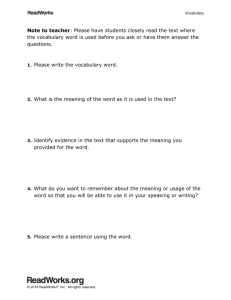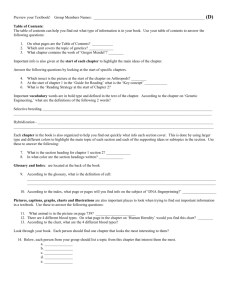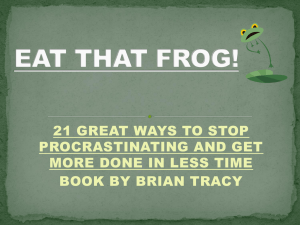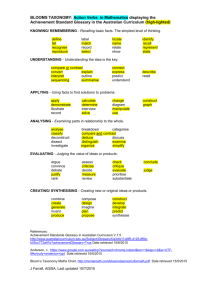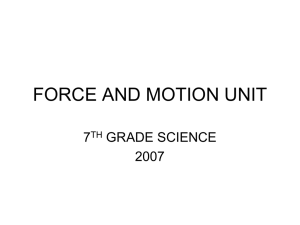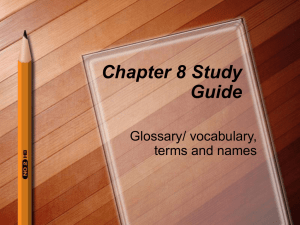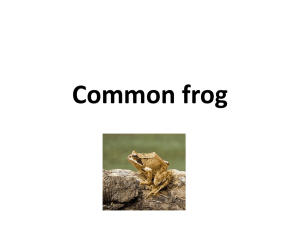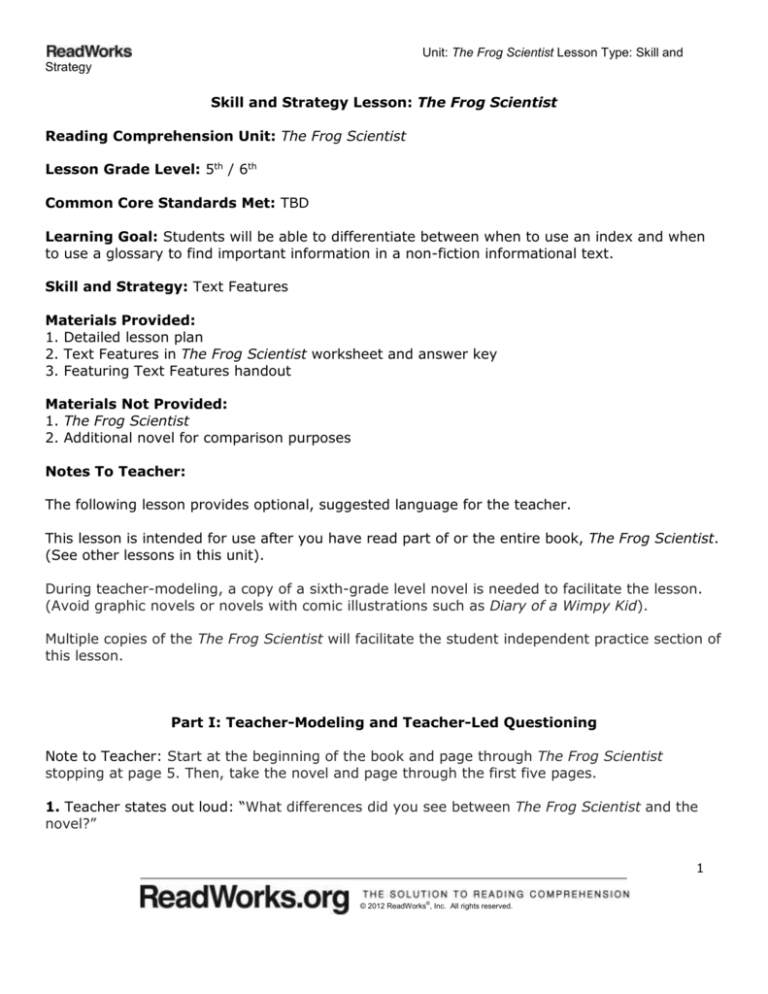
Unit: The Frog Scientist Lesson Type: Skill and
Strategy
Skill and Strategy Lesson: The Frog Scientist
Reading Comprehension Unit: The Frog Scientist
Lesson Grade Level: 5th / 6th
Common Core Standards Met: TBD
Learning Goal: Students will be able to differentiate between when to use an index and when
to use a glossary to find important information in a non-fiction informational text.
Skill and Strategy: Text Features
Materials Provided:
1. Detailed lesson plan
2. Text Features in The Frog Scientist worksheet and answer key
3. Featuring Text Features handout
Materials Not Provided:
1. The Frog Scientist
2. Additional novel for comparison purposes
Notes To Teacher:
The following lesson provides optional, suggested language for the teacher.
This lesson is intended for use after you have read part of or the entire book, The Frog Scientist.
(See other lessons in this unit).
During teacher-modeling, a copy of a sixth-grade level novel is needed to facilitate the lesson.
(Avoid graphic novels or novels with comic illustrations such as Diary of a Wimpy Kid).
Multiple copies of the The Frog Scientist will facilitate the student independent practice section of
this lesson.
Part I: Teacher-Modeling and Teacher-Led Questioning
Note to Teacher: Start at the beginning of the book and page through The Frog Scientist
stopping at page 5. Then, take the novel and page through the first five pages.
1. Teacher states out loud: “What differences did you see between The Frog Scientist and the
novel?”
1
© 2012 ReadWorks®, Inc. All rights reserved.
Unit: The Frog Scientist Lesson Type: Skill and
Strategy
Suggested student response: “The Frog Scientist has a table of contents, photographs and
captions along with text, and the novel mainly has text with perhaps a few drawings.”
Note to Teacher: If the novel also has a table of contents, point that out as a similarity.
2. Teacher states out loud: “Now, let’s look at the last 6 pages of the Frog Scientist (beginning
with the Index on page 52) and the last 6 pages of the novel.”
3. Teacher states out loud: “What differences did you see between The Frog Scientist and the
novel?”
Suggested student response: Answers may vary, but should include: “The Frog Scientist
ends with a Glossary; which are pages with lists of information about frogs and toads,
Acknowledgments; thanks to the people who helped the author write the book, Index;
while the novel ends the way it began, with unadorned text.”
4. Teacher states out loud: “The differences we have noticed – the table of contents, the
pictures and captions, the index and the glossary – are called text features. A text feature is a
device in a text that organizes and emphasizes information. Authors use text features to help
readers find and understand textual details more easily.”
5. Teacher asks students: “What is a text feature? Why do authors use text features?”
Suggested student response: “A text feature is something that organizes and emphasizes
certain information. Authors use text features to help readers find and understand textual
details more easily.”
6. Teacher states out loud: “We will focus on the two text features that we saw in last pages of
The Frog Scientist – the index and the glossary. These text features can help us locate
information in the text and understand unfamiliar words in the text when we encounter them.”
Note to Teacher: Distribute the “Featuring Text Features Handout.”
7. Teacher states out loud: “In this lesson, we will discuss and use the first three terms (table of
contents, index, glossary).”
8. Teacher asks students: “Who can read the definition of the Table of Contents from the
‘Featuring Text Features Handout?’”
Suggested student response: “A Table of Contents is a list of chapters or divisions in a
book and the pages on which they start.”
9. Teacher asks students: “When looking at the Table of Contents, What do you notice about
the table of contents in The Frog Scientist?”
2
© 2012 ReadWorks®, Inc. All rights reserved.
Unit: The Frog Scientist Lesson Type: Skill and
Strategy
Suggested student response: Answers will vary, but should include:
-
Chapter titles of the main part of the text are in large print
The lower section starting with Glossary, pages 52-58, is in smaller print
10. Teacher states out loud: “The difference in the size of the text helps the reader see where
the main text ends and some of the text features begin. Notice the glossary is on page 52 and
the index is on page 58.”
11. Teacher asks students: “Who can read the definition of the word ‘Glossary’ from the
‘Featuring Text Features Handout?’”
Suggested student response: “A glossary is a list of special or difficult words in a book,
along with their definitions.”
12. Teacher states out loud: “Turn to the Glossary on page 52. Notice the terms in the glossary
all have to do with frogs and the science of frogs, and that they are terms the author might think
that a reader would not already know. A glossary contains words that are specific to the topic of
a book, and finding out what those words mean will help a reader understand the text better.”
13. Teacher asks students: “Who can read the definition of the word ‘Index’ from the ‘Featuring
Text Features Handout?’”
Suggested student response: “An index is an alphabetized list of different topics in a book
and the page numbers where these topics are mentioned throughout the book.”
14. Teacher states out loud: “Turn to the index on page 58. Notice the index does not have the
information, just the page numbers for the information, but it saves a reader time to consult the
index because the reader does not have to search through the whole book and can go directly to
the pages where the information can be found.”
15. Teacher asks students: “What is a similarity between the glossary and the index?”
Suggested student response: “Both the index and glossary are organized in alphabetical
order.”
16. Teacher asks students: “How are the glossary and index different?”
Suggested student response: “The glossary is a list of terms and definitions, while an
index is a list of topics and page numbers where these topics can be found in the text.”
17. Teacher states out loud: “Now I will show you how to decide when to use the index and
when to use the glossary to find information in the text.”
3
© 2012 ReadWorks®, Inc. All rights reserved.
Unit: The Frog Scientist Lesson Type: Skill and
Strategy
18. Teacher asks students: “I have projected the ‘Text Features and The Frog Scientist’
worksheet on the board. Who can read the directions?”
Suggested student response: “Read each question. Then circle the text feature that
should be used and answer why you chose that feature. Save the challenge part for later!”
19. Teacher states out loud: “The first question on the worksheet says, ‘Maria wants to learn
about Tyrone’s assistant Young Kim-Parker and the work that she does to help Tyrone in his
experiment about atrazine and frogs.’”
20. Teacher states out loud: “I need to figure out which text feature should she use and why.
Maria is looking for information, not the meaning of a word, and so she should use the index.
She will find the page numbers for the information that she needs and can go and read those
pages to answer her question. Circle the word ‘index’ in the second column and write ‘Maria
needs to find information in the text.’ under ‘Why?’ in the third column. Remember, we will save
the Challenge column for later!”
21. Teacher states out loud: “The second question states, ‘Julian learned that the frogs that
grew up in water with no atrazine are the control group for Tyrone’s experiment. He does not
know what a control group is.’”
22. Teacher states out loud: “Again, I need to figure out which text feature Julian should use
and why. Julian is trying to figure out the meaning of a term and should use the glossary, which
will give him a definition. Circle the word ‘glossary’ in the second column and write ‘Julian is
looking for the definition of a word.’ under ‘Why?’ in the third column.”
Part II. Guided Practice and Discussion
1. Teacher states out loud: “Now we will practice together deciding when to use the index and
when to use the glossary to find information in the text.”
2. Teacher asks students: “Who can read the third question aloud?”
Suggested student response: “Ella read in The Frog Scientist that Tyrone removes the
frog’s kidneys before examining them under a microscope. She does not understand what
kidneys are.”
3. Teacher asks students: “Which text feature should Ella use and why?”
Suggested student response: “Ella needs to find the definition of a word and should
consult the glossary.”
4
© 2012 ReadWorks®, Inc. All rights reserved.
Unit: The Frog Scientist Lesson Type: Skill and
Strategy
4. Teacher states out loud: “Circle the word ‘glossary’ in the second column and write ‘Ella is
looking for the definition of a word.’ under ‘Why?’ in the third column.”
Part III. Student Independent Practice
1. Teacher states out loud: “Now it is your turn to complete the fourth question independently.
When you are done raise your hand silently to indicate you are ready.”
Note to Teacher: Move around the room to determine when most or all students are finished
with the fourth question.
2. Teacher asks students: “Who can read the fourth question?”
Suggested student response: “Eddie wants to write a report about how some kinds of
frogs have become extinct.”
3. Teacher asks students: “Which text feature should Eddie use and why?”
Suggested student response: “Eddie is looking for information about a topic and should
look at the index to find the page number where this information can be found. I circled
the word ‘index’ in the second column and wrote ‘Eddie is looking for information in the
text.’ in the third column.”
4. Teacher asks students: “Will Eddie find the information he is looking for in the index itself?”
Suggested student response: “No, Eddie will not find the information he is looking for in
the index itself. The information he needs is in the text, and the index will tell him the
page numbers he can go to and find the information he is looking for.”
5. Teacher asks students: (Closure) “Who can remind the class what the two text features were
that we studied today?”
Suggested student response: “We studied the index and glossary.”
6. Teacher asks students: “Can I have another volunteer to review what an index is?”
Suggested student response: “An index is a list of difficult or topic-related words from the
text and their meanings.”
7. Teacher asks students: “Can I have another volunteer to tell the group what a glossary is?”
Suggested student response: “A glossary is a list of topics that can be found in the text
and the page numbers where they can be found.”
5
© 2012 ReadWorks®, Inc. All rights reserved.
Unit: The Frog Scientist Lesson Type: Skill and
Strategy
8. Teacher asks students: “Lastly, how are a glossary and an index are organized?”
Suggested student response: “A glossary and index are both organized alphabetically.”
9. Teacher states out loud: “Look at the completed worksheet on the board. All the questions
you answered were real questions or tasks related to the text. You could use the glossary or
index to answer the questions posed to further complete the task.”
10. Teacher states out loud: “Remember that text features in informational text such as the
index or the glossary are there to help you the readers find and understand information more
easily.”
Note to Teacher (Extension):
Challenge students to work either independently, in partners, or in small groups to use the index
and glossary to actually find the information that the students in the worksheet questions were
seeking. If time permits, students can try to find the answers for all four. If not, assign different
groups to do different questions. Tell students that in each case, they should pretend to be the
student in the question, and try to solve the problem or complete the task by using the index or
glossary, as needed. Remind them that if they are using the index, they will have to go to the
pages indicated and read those pages to find the information.
6
© 2012 ReadWorks®, Inc. All rights reserved.
Unit: The Frog Scientist Lesson Type: Skill and
Strategy
Featuring Text Features
Text Feature
Description
A list of chapters or divisions in a
book and the pages on which they
start.
A list of special or difficult words in a
book, along with their definitions.
Table of Contents
Glossary
An alphabetized list of different
topics in a book and the page
numbers where these topics are
mentioned throughout the book.
Photographs provide visual
documentation of an event or person
in a book. Captions provide the main
idea of the photograph.
The title of a paragraph, section, or
chapter of a book. Subheadings
further break down the subject of a
heading.
Bolded text is printed text that is
heavier or darker than regular text.
Italicized texts are slanted. Both
bolded and italicized texts
emphasize information.
Ilustrations are drawn pictures that
support an image in a text.
Index
Photographs and Captions
Heading and Subheadings
Bold and Italicized Text
Illustrations
Maps
Diagrams, Charts, and Graphs
Timelines
A representation of a place in a
book. Maps can show points of
interest, the distance or relationship
between different places, and the
journey a character or person takes
in a place.
Diagrams, charts, and graphs are
visual representations that show the
relationship between different parts.
Timelines shows the sequence of
important events in the order in
which they occurred.
7
© 2012 ReadWorks®, Inc. All rights reserved.
Unit: The Frog Scientist Lesson Type: Skill and Strategy
Text Features in The Frog Scientist
Name: _______________________________
Date: ________________
Directions: Read each question. Then circle the text feature that should be used and answer why you chose that
feature. Save the challenge part for later!
Question
Text
Feature
Why
Challenge
(Circle one)
1. Maria wants to learn
about Tyrone’s
assistant Young KimParker and the work
that she does to help
Tyrone in his
experiment about
atrazine and frogs.
Which text feature
should she use and
why?
2. Julian learned that
the frogs that grew up
in water with no
atrazine are the control
group for Tyrone’s
experiment. He does
not know what a
control group is. Which
text feature should he
use and why?
Index
or
Glossary
Index
or
Glossary
8
© 2012 ReadWorks®, Inc. All rights reserved.
Unit: The Frog Scientist Lesson Type: Skill and Strategy
3. Ella read that Tyrone
removed the frog’s
kidneys before
examining them under
a microscope. She
does not understand
what kidneys are.
Which text feature
should she use and
why?
4. Eddie wants to write
a report about how
some kinds of frogs
have become extinct.
Which text feature
should he use and
why?
Index
or
Glossary
Index
or
Glossary
9
© 2012 ReadWorks®, Inc. All rights reserved.
Unit: The Frog Scientist Lesson Type: Skill and Strategy
Answer Key
Independent Practice: Text Features in The Frog Scientist
Directions: Read each question. Then circle the text feature that should be used and answer why you chose that
feature. Save the challenge part for later!
Question
1. Maria wants to learn
about Tyrone’s assistant
Young Kim-Parker and the
work that she does to
help Tyrone in his
experiment about atrazine
and frogs. Which text
feature should she use
and why?
2. Julian learned that the
frogs that grew up in
water with no atrazine are
the control group for
Tyrone’s experiment. He
does not know what a
control group is. Which
text feature should he use
and why?
Text Feature
(Circle one)
Why
Index
or
Maria needs to find information
in the text.
Challenge
Young Kim-Parker joins Tyrone on the
field trips to collect frogs for his
experiments, helps to care for the
tadpoles in the lab, and gets slides
ready for the microscopes.
Glossary
Index
or
Julian is looking for the
definition of the term “control
group.”
Glossary
A control group is a group used as a
standard of comparison in an
experiment. A control group is as
similar to the experimental group as
possible but doesn’t receive the
treatment under investigation.
10
© 2012 ReadWorks®, Inc. All rights reserved.
Unit: The Frog Scientist Lesson Type: Skill and Strategy
3. Ella read that Tyrone
removed the frog’s
kidneys before examining
them under a microscope.
She does not understand
what kidneys are. Which
text feature should she
use and why?
4. Eddie wants to write a
report about how some
kinds of frogs have
become extinct. Which
text feature should he use
and why?
Index
Ella needs to find out what the
word “kidney” means.
Kidneys are a pair of bean-shaped
organs that filter wastes from the
blood and excrete the wastes (mixed
with water) as urine.
Eddie is looking for information
in the text.
About a third of the amphibians may
become extinct and at least 122
species probably have already,
including the gastric brooding frog and
the golden toad. Some extinction
comes from habitat loss, but some
comes from reasons that scientists do
not understand.
or
Glossary
Index
or
Glossary
11
© 2012 ReadWorks®, Inc. All rights reserved.

